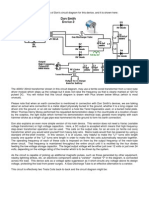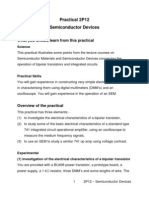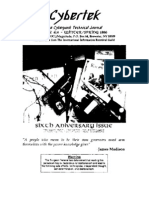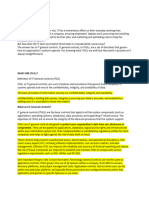GBPPR 'Zine - Issue #65
GBPPR 'Zine - Issue #65
Uploaded by
GBPPRCopyright:
Available Formats
GBPPR 'Zine - Issue #65
GBPPR 'Zine - Issue #65
Uploaded by
GBPPRCopyright
Available Formats
Share this document
Did you find this document useful?
Is this content inappropriate?
Copyright:
Available Formats
GBPPR 'Zine - Issue #65
GBPPR 'Zine - Issue #65
Uploaded by
GBPPRCopyright:
Available Formats
GBPPR 'Zine
Issue #65
The Monthly Journal of the American Hacker
September 2009
"... grievous mental suffering inflicted upon Libellant by Libellee" Listed reason on the March 10, 1964 divorce papers between Stanley Ann Obama (Libellant) and Barack Hussein Obama (Libellee). I wonder if we can divorce the U.S. from our Barack Hussein Obama! LOL! Change!
Table of Contents Page 2 / Intelligent Simplex Peripheral Interface / #1A ESS (Part 3) Translation and recent change implementation prodcedures for the ISPI interface under a #1A ESS. Page 18 / GBPPR Homebrew Radar Experiment: HighVoltage Power Supply Beginning experiment to construct all the parts for your own radar system. Page 31 / GBPPR Homebrew Radar Experiment: PulseForming Network Ideas to construct the main pulselength determining component in a radar system. Page 46 / Motorola Bag Phone RF Info RF power output and spectrum plot for an old Motorola bagstyle cellular phone. Page 47 / Bonus Heathkit H100 Ad Page 48 / The End Editorial and rants.
Intelligent Simplex Peripheral Interface / #1A ESS
Intelligent Simplex Peripheral Interface / #1A ESS
Intelligent Simplex Peripheral Interface / #1A ESS
Intelligent Simplex Peripheral Interface / #1A ESS
Intelligent Simplex Peripheral Interface / #1A ESS
Intelligent Simplex Peripheral Interface / #1A ESS
Intelligent Simplex Peripheral Interface / #1A ESS
Intelligent Simplex Peripheral Interface / #1A ESS
Intelligent Simplex Peripheral Interface / #1A ESS
10
Intelligent Simplex Peripheral Interface / #1A ESS
11
Intelligent Simplex Peripheral Interface / #1A ESS
12
Intelligent Simplex Peripheral Interface / #1A ESS
13
Intelligent Simplex Peripheral Interface / #1A ESS
14
Intelligent Simplex Peripheral Interface / #1A ESS
15
Intelligent Simplex Peripheral Interface / #1A ESS
16
Intelligent Simplex Peripheral Interface / #1A ESS
17
GBPPR Homebrew Radar Experiment
HighVoltage Power Supply
Overview One of the biggest experiments I've always wanted to work on is a homebrew radar system. No, not some pussy ultrasonic range finder using premade kits, but a true highpower pulse (and maybe Doppler) radar system. And I think it's now possible... This project will be continuously "in development." I have no idea if the final outcome will even work, but I'll try to make all the experiments public and fairlywell documented. The overall work will be done in a series of subsections over the next few months (or even years). If it all works great. If it doesn't... It'll look cool, and you'll have nice beacon to attract antiradiation missles. The first series of this radar project will be building fairly wellregulated and stable highvoltage power supply. This project will be mostly a tweaking of the "Simple 4 kVDC Power Supply" project from GBPPR 'Zine, Issue #47. Be sure to refer to that article for all the nittygritty details on using microwave oven highvoltage transformers in highvoltage power supply applications. This power supply's main rework will be the addition of a 0120 VAC Variac on the microwave oven transformer's primary input. The Variac will allow you to "regulate" the transformer's final output voltage between 01,900 VAC. Since the output current and voltage requirements for a radar system are surprisingly not too demanding, we can eliminate alot of the highvoltage filtering capacitors and easily beefup the diode bridge rectifier circuit. A conventional bridge rectifier circuit will be on the secondary output of the microwave oven transformer to give a maximum DC voltage output of around 2,500 volts (1,900 * 1.414). Regulating the transformer's primary input AC voltage to approximately 91 volts will give a final (unloaded) DC output of around 2,000 volts. Radar Block Diagram
18
Pictures & Construction Notes
0.55 F / 2,300 VAC microwave oven voltagedoubling capacitor. First, we'll show a little tip to salvage 10 Megaohm resistors capable of operating at highvoltages (2+ kilovolts). Every highvoltage microwave oven capacitor should have an internal 10 Megaohm resistor across the leads to help drain the highvoltage charge when the AC power is off. We can salvage these resistors for use in highvoltage divider networks or for drain resistors in your own power supply circuits.
19
Start by cutting the bottom off the capacitor with a hacksaw. The capacitor will leak its dielectric fluid, so be prepared. The fluid should be nontoxic, but be careful.
20
Use a needlenose pliers to pull out the wrapped foil package which makes up the actual capacitor. It will be attached by its two leads, but should easily pull out with just a quick tug. You'll want to then begin peeling back the outside case of the capacitor. This should expose the resistor across the capacitor's two terminals. The resistor will be mounted on a ceramic substrate, so be careful removing it so it doesn't crack. You can clip or unsolder the leads, as necessary.
21
Salvaging the original 4 kV power supply circuit. Remove the internal components, leaving the AC input socket, fuse, neon lamp, AC line filter, and power switch. We'll be adding a separate fuse to protect the output of the Variac. The BNC connector will be an optional "HighVoltage Test Point" for monitoring the power supply's DC output via a "divideby100" resistive network. It think the BNC connector should have been an isolated version to help keep a singlepoint ground.
22
Mount the Variac to the frontpanel of the case. The little green blob on the Variac's AC input is a surgesuppression PTC resistor from an old computer/monitor switching power supply. This is used to limit the input current rush on power up. The blue series capacitorresistor network form a snubber to clamp any voltage spikes from the Variac's primary winding on power up or down.
23
Install the highvoltage filtering capacitors. Shown here are two Aerovox 2 F, 2,000 WVDC capacitors I found at a hamfest. Several paralleled microwave oven capacitors will also work, but try to keep them all the same value. Be sure to take proper highvoltage contruction and mounting considerations into play when working around these capacitors. The AC output of the Variac connects to the terminal block shown on the top of the picture.
24
Solidstate, highvoltage bridge rectifier circuit. The four diodes are HVPR1606, but you can also use the highvoltage diodes from a microwave oven's voltagedoubler circuit, if they're the same. Each of the highvoltage diodes has a 3,300 pF / 3 kV capacitor across it. These are to help suppress any switching transients. The red capacitor is a 8,200 pF / 3 kV, and is wired across the microwave oven transformer's secondary output. This is to also help suppress any highvoltage transients.
25
Completed highvoltage power supply internal overview. A 10 ohm / 5 watt resistor was added in series from the bridge rectifier's positive DC output to help tame any current surges which could destroy the highvoltage diodes. The microwave oven transformer is mounted against a sheet of rubber gasket to dampen any vibrations. The transformer doesn't need any extra highvoltage isolation in this application.
26
Completed highvoltage power supply internal overview. Alternate view. Note the 10 Megaohm resistor across one of the highvoltage filtering capacitors on the right. Also note the use of rubber grommets and zip ties to isolate and secure any wires carrying highvoltage. The highvoltage output is via the two isolated banana jacks on the upperright. A ferrite bead was slipped over the positive output wire. The output of the Variac is tapped, ran through a fuse, and sent to the banana jacks on the upperleft.
27
Overview showing behind the frontpanel and the Variac wiring.
28
Completed highvoltage power supply overview. The final DC output is adjustable from 0 to 2,500 VDC, but we'll only be using an output of 2,000 VDC for this radar project. The BNC jack provides a "divideby100" voltage test point. It should read "20 Volts" when the power supply is set to an output of 2,000 VDC.
29
30
GBPPR Homebrew Radar Experiment
PulseForming Network
Overview The main component in a radar system that determines the RF pulse length is a passive circuit called the PulseForming Network (PFN). This circuit is essentially a lumpedcomponent inductor/capacitor version of a long piece of coaxial cable, in that is has a delay time and impedance. The number of inductor/capacitor sections in the pulseforming network determines the overall pulse length, usually a microsecond or so. The ratio of inductor/capacitors also sets the impedance of the PFN. The impedance will stay the same, regardless of the number of L/C sections, provided the inductors/capacitors maintain the same value. When operating, the PFN is charged to a highvoltage DC potential (we'll be using 2,000 volts) and is quickly discharged to ground using a thyratron or other type of highspeed trigger. Since the PFN is connected in series with the pulse transformer's primary, the discharge induces a large voltage spike equal to onehalf the charging voltage in the pulse transformer's primary windings. This voltage pulse is equal in length to the PFN's delay time. The voltage pulse is further steppedup via the pulse transformer's secondary winding and is finally applied to the magnetron's cathode. The PFN's impedance is also steppedup via the pulse transformer to help match the magnetron's operating impedance, which is usually around 1,200 ohms. Impedance matching helps to keep the transmitted RF pulse from being "deformed." Pulse transformer operation will be covered in better detail in an upcoming article. The PFN we'll be using is the most widely used version, the typeE pulseforming transmission line. This consists of a single ferrite core with a number of winding taps for the capacitors.
Example: Using five 10 H inductors and five 1,000 pF capacitors; you would have a PFN with a pulse width of 1 S and an impedance of 100 ohms.
31
Pictures & Construction Notes
Parts for our homebrew pulseforming network. The main L/C components are a 10 mm diameter ferrite rod antenna from an old "autosetting" clock (CMAX CMA60100 or similar), and five 1,000 pF / 4 kV capacitors. The inductors will be wound on the ferrite rod using #22 enameled wire. The ferrite rod will be attached to an optional fiberglass base using two rubber grommets to isolate and secure it. The white square things are adhesivebacked cable tie mounts. Optional solderterminals will be used for holding one end of the capacitors. This is all a total hack, and I'm not even sure it's correct. I've never even seen a PFN in reallife. Seriously...
32
Forming the inductors. To help secure the windings, wrap the ferrite rod with some doublesided sticky tape. Wind about 12 turns of #22 enameled wire to make a 10 H inductor. You may need to tweak the number of required turns, depending on the composition of the ferrite rod. Make the five inductor sections, as shown above, then secure the windings with some Qdope or other type of glue. Be sure to leave a little space on the ferrite rod to attach the grommets. The PFN will generate highcurrents, but only for a short time, so it pays to use heavier gauge wire.
33
When finished, secure and wrap the inductors with a few turns of Teflon plumbers tape. Attach the ferrite rod to the base by wrapping zip ties around the grommets and attaching them to adhesivebacked mounting points on the base. Mounting the PFN on a separate base is optional, but should help to make it easier to swap out if you need to change the radar's pulse length.
34
Completed pulseforming network. One lead of the highvoltage 1,000 pF capacitors is soldered to a terminal, the other is supported by the inductor windings. The highvoltage DC charging positive input is via the terminal on the lowerleft. The output is via any other terminal. The entire PFN assembly will be mounted on standoffs to allow for highvoltage isolation. A very detailed description of how pulseforming networks operation (and other radar operations) is available in the "U.S. Army Aviation Course Subcourse MM5005: Radar Transmitter" manual. This manual is available online at: http://www.tpub.com/content/armymunitions/mm50058/index.htm
35
A Textbook of Radar (Pulled from Google Books, so it is missing a few pages.)
36
37
38
39
40
41
Microwaves and Radar Electronics (Excerpt from Chapter 5 Pulse Circuits)
42
43
44
45
Motorola Bag Phone RF Info
Overview Finally got a chance to look at an old Motorola bagstyle cellular phone on an IFR1200S service monitor. RF power output and a spectrum analyzer shot are shown before. The phone was in "test mode," with pin 21 on the DB25 tied to ground. The test frequency was 837.000 MHz. Enter 110400# on the keypad while in test mode to set the phone to that frequency. The phone's RF output power is set with the 12x# keypad entry. Where "x" is either 0, 1, 2, 3, or 4. Highest output power is with the "120#" option. The RF output seemed unstable while on the "124#" option, so stick with "123#" and pad down the RF power level with a resistive attenuator pad. Most commerical doublebalanced mixers needs a +7, +10, +13, or +17 dBm input LO signal, if you use the phone for this application.
Motorola Test Mode Command 120# 121# 122# 123# 124# 125# 126# 127# 128# 129# RF Output Power (Watts) 2.57 0.85 0.30 0.10 0.02 No RF Output No RF Output No RF Output No RF Output No RF Output RF Output Power (dBm) +34.1 +29.3 +24.8 +20.0 +13 No RF Output No RF Output No RF Output No RF Output No RF Output
Spectrum analyzer screen capture of a Motorola bagstyle cellular phone, in testmode, transmitting at 837 MHz. The horizontal setting is 20 kHz per division. Vertical is 10 dB per division. 46
Bonus
Most of today's "hackers" can barely find the power button on their computer. 47
End of Issue #65
Any Questions? Editorial and Rants Michael Moore sure hates capitalism! From: gatewaypundit.blogspot.com/2009/09/tomichaelmoorecapitalismisevil.html Just some data for if you run a piece on Michael Moore's new movie. Capitalism sure has been evil for Mike. For reference, Torch Lake is among the two or three most desirable places to live in Northern Michigan. Normally, Michael Moore says that Traverse City (96% White!) is his adopted hometown, or lies and says that he lives in Bellaire, like he has some kind of log cabin in the woods. Nope, his home is an expensive house on 150 ft. of lake frontage.
Property Information Owner Name(s): Property Address: Current Taxable Value: School District: Current Assessment: Current Homestead: Current Property Class: Last Year's Assessment: Last Year's Homestead: Last Year's Property Class: Lake Frontage: Waterfront Footage: Michael Moore & Kathleen Glynn Central Lake, MI 49622 $390,976 Bellaire $647,200 100% 40 Residential $647,200 100% 40 Residential Torch Lake 150.48 ft.
"Get me some fried chicken! Errr... Capitalism is bad!"
48
Some Pictures from the Tea Partys
49
50
Compared to the professionallymade, Sorosfunded, proObama signs. 51
Back on June 8th, Barack Obama promised to speed up the stimulus projects over the summer and to "create or save" 600,000 jobs. The AP reported: "President Barack Obama is promising to speed federal money into hundreds of public works projects this summer, vowing that 600,000 jobs will be created or saved." The U.S. lost 443,000 jobs in June. The U.S. lost 247,000 jobs in July. The U.S. lost 216,000 jobs in August. Instead of creating or saving 600,000 jobs this summer, the U.S. lost 935,000 instead. The unemployment rate is at 9.7%, the highest rate in 26 years. Thanks Barack.
52
53
54
55
Wait... You mean the mainstream media can't be trusted? Public Trust in U.S. Media Eroding: Pew Study September 14, 2009 From: news.yahoo.com WASHINGTON (AFP) Public trust in the U.S. media is eroding and increasing numbers of Americans believe news coverage is inaccurate and biased, according to a study released on Monday. Just 29 percent of the 1,506 adults surveyed by the Pew Research Center for the People and the Press between July 2226 said news organizations generally get the facts straight. Sixtythree percent said news stories are often inaccurate, up from 34 percent in a 1985 study, Pew said. Sixty percent of those polled said the press is biased, up from 45 percent in 1985. Just 26 percent in the latest survey said that news organizations are careful their reporting is not politically biased. Seventyfour percent said news organizations tend to favor one side in dealing with political and social issues. Eighteen percent said they deal fairly with all sides. Pew said Republicans tend to be more critical of the news media than Democrats although negative attitudes toward the news media were also increasing among Democrats. Fiftynine percent of those who identified themselves as Democrats said news organizations are often inaccurate, up from 43 percent just two years ago. Twothirds of the Democrats polled said the press tends to favor one side rather than to treat all sides fairly, up from 54 percent in 2007. Just 20 percent of those polled said news organizations are independent of powerful people and organizations and only 21 percent said they are willing to admit their mistakes. The poll found television remained the dominant news source for the public, with 71 percent saying they get most of their national and international news from television. Fortytwo percent said they get most of their news from the Internet compared with 33 percent who cited newspapers. Fiftynine percent rated news organizations as "highly professional," down from 66 percent two years ago and 72 percent in 1985. Sixtytwo percent of those polled said news organizations are being fair to the Obama administration while 23 percent said media coverage has been unfair. Forty percent said the major cable news outlets CNN, Fox News and MSNBC were their main source for national and international news with 22 percent saying they relied on CNN, 19 percent on Fox and six percent on MSNBC. Seventytwo percent of Republicans view Fox News positively compared with just 43 percent of Democrats. 56
Those polled were starkly divided along party lines when it came to the New York Times. Republicans viewed the Times negatively by a margin of 31 percent to 16 percent while Democrats viewed it positively by 39 percent to eight percent margin. Sixtyeight percent of those polled said it would be a major loss if large national newspapers like the Times, USA Today and the Wall Street Journal were to stop publishing. The survey had a margin of error of between plus or minus three percentage points.
Gee... I can't imagine why!
Free State Project www.freestateproject.org
57
58
You might also like
- Hansgeorg Gadamer Gadamer On Celan Who Am I and Who Are You and Other Essays 1Document191 pagesHansgeorg Gadamer Gadamer On Celan Who Am I and Who Are You and Other Essays 1Martin JeanNo ratings yet
- Flyback TransformersDocument17 pagesFlyback TransformersRICHIHOTS2No ratings yet
- Zilano 2Document22 pagesZilano 2blargbl100% (5)
- It Is Quite Another Electricity: Transmitting by One Wire and Without GroundingFrom EverandIt Is Quite Another Electricity: Transmitting by One Wire and Without GroundingRating: 4.5 out of 5 stars4.5/5 (2)
- GBPPR 'Zine - Issue #38Document70 pagesGBPPR 'Zine - Issue #38GBPPRNo ratings yet
- Tired of Low Battery Voltage? Build A Step-Up DC-DC Converter!Document2 pagesTired of Low Battery Voltage? Build A Step-Up DC-DC Converter!ferreira_tomarNo ratings yet
- GBPPR 'Zine - Issue #68Document76 pagesGBPPR 'Zine - Issue #68GBPPRNo ratings yet
- Ebook Emp Herf Shock Pulse Generators Empplans 400j 1.8gw Plan Gun WeaponDocument22 pagesEbook Emp Herf Shock Pulse Generators Empplans 400j 1.8gw Plan Gun Weaponarmandoaltomare100% (2)
- 2.2.06 DiDocument5 pages2.2.06 DiMauro MarafonNo ratings yet
- Transformer Less Power Supply For MicrocontrollersDocument11 pagesTransformer Less Power Supply For MicrocontrollersSentimental SagNo ratings yet
- GBPPR Electromagnetic Pulse Experiments - Part 1Document19 pagesGBPPR Electromagnetic Pulse Experiments - Part 1tutankamon20010No ratings yet
- All American FiveDocument12 pagesAll American Fivejaapie666No ratings yet
- Emp 400Document5 pagesEmp 400Ishwar SharmaNo ratings yet
- High Frequency Plasma Circuit (Electronic Ion Pump)Document3 pagesHigh Frequency Plasma Circuit (Electronic Ion Pump)Peter Benedikt Weber100% (2)
- X-10 Compatible Appliance ModuleDocument0 pagesX-10 Compatible Appliance ModuleburdinskiNo ratings yet
- BGW Model 250 Stereo Power AmplifierDocument22 pagesBGW Model 250 Stereo Power AmplifierRdguez KandeNo ratings yet
- A 2kVA 12VDC To 120VAC Inverter For Power BackupDocument26 pagesA 2kVA 12VDC To 120VAC Inverter For Power Backuplm69No ratings yet
- GBPPR 'Zine - Issue #66Document77 pagesGBPPR 'Zine - Issue #66GBPPRNo ratings yet
- 25839-Designing Offline Ac DC Switching Power Supplies Brick by Brick PDFDocument9 pages25839-Designing Offline Ac DC Switching Power Supplies Brick by Brick PDFAshwin KonaleNo ratings yet
- Exercise On Analog Circuits: PHYS 331: Junior Physics Laboratory IDocument6 pagesExercise On Analog Circuits: PHYS 331: Junior Physics Laboratory Iviso167No ratings yet
- Overview of SubstationDocument38 pagesOverview of SubstationHarish Pamuru100% (1)
- PTCUL Substation Training ReportDocument24 pagesPTCUL Substation Training ReportChetan Sharma100% (1)
- Switchyard & Its Equipment AND HVDC Transmission: Deepak Kumar SahuDocument36 pagesSwitchyard & Its Equipment AND HVDC Transmission: Deepak Kumar SahuDeepak Kumar SahuNo ratings yet
- Super Capacitor BatteryDocument2 pagesSuper Capacitor Batterybuditux100% (1)
- Superfast Rechargable BatteryDocument3 pagesSuperfast Rechargable BatteryAmandeep SinghNo ratings yet
- The Giant Book of Electronics ProjectsDocument496 pagesThe Giant Book of Electronics Projectsvoip5430198% (46)
- Switch Yard and Its EquipmentsDocument48 pagesSwitch Yard and Its Equipmentsamit joshi86% (14)
- GR Exp 1926 - 12Document4 pagesGR Exp 1926 - 12PedralhadaNo ratings yet
- GBPPR Homebrew Radar ExperimentDocument15 pagesGBPPR Homebrew Radar ExperimentRobert EckardtNo ratings yet
- 33 KV SubstationDocument19 pages33 KV Substationraju chandanshiveNo ratings yet
- Ee6303 - Linear Integrated Circuits and ApplicationsDocument19 pagesEe6303 - Linear Integrated Circuits and ApplicationsBALAKRISHNANNo ratings yet
- Design, Simulation and Construction of Cockroft Walton Voltage MultiplierDocument5 pagesDesign, Simulation and Construction of Cockroft Walton Voltage MultiplierGRD JournalsNo ratings yet
- Build A Low Cost Magnetic PulserDocument10 pagesBuild A Low Cost Magnetic PulserHaSophim100% (7)
- AM Receiver: Home Analysis Help Media Links PracticalDocument10 pagesAM Receiver: Home Analysis Help Media Links PracticalĐinh Văn HiếuNo ratings yet
- td750 457backtobackDocument3 pagestd750 457backtoback41005064No ratings yet
- Presentation - Best Practice Earthing and ProtectionDocument42 pagesPresentation - Best Practice Earthing and ProtectionMahesh Chandra Manav100% (2)
- A 150 MHZ RF Signal GeneratorDocument17 pagesA 150 MHZ RF Signal GeneratorPatrik1968No ratings yet
- x10 CouplersDocument12 pagesx10 CouplerspedroNo ratings yet
- A Report On IIUC Substation-3 (Beside FSE)Document8 pagesA Report On IIUC Substation-3 (Beside FSE)Sajjadul IslamNo ratings yet
- Power CapacitorsDocument63 pagesPower Capacitorswasik100% (1)
- Clap SwitchDocument16 pagesClap SwitchPiyush RamawatNo ratings yet
- Intern Ship Report of 132Kv Grid StationDocument81 pagesIntern Ship Report of 132Kv Grid Stationdarkroom92% (25)
- T&D Supply SystemDocument93 pagesT&D Supply SystemAnil PalamwarNo ratings yet
- CT154 (Anglais)Document31 pagesCT154 (Anglais)kamlzNo ratings yet
- Tips ProtecciónDocument6 pagesTips ProtecciónOscar GarciaNo ratings yet
- HV Power Supply PDFDocument6 pagesHV Power Supply PDFvshalshethNo ratings yet
- Practical 2P12 Semiconductor Devices: What You Should Learn From This PracticalDocument11 pagesPractical 2P12 Semiconductor Devices: What You Should Learn From This PracticalDevesh GargNo ratings yet
- Irjet V3i7155 PDFDocument5 pagesIrjet V3i7155 PDFharikrishnan t cNo ratings yet
- Regulated DC Power Supply Lab AssignmentDocument17 pagesRegulated DC Power Supply Lab AssignmentSebastien Paul100% (1)
- Grid Tie Inverter Version 3Document17 pagesGrid Tie Inverter Version 3ghjNo ratings yet
- WMCDocument65 pagesWMCbhagathnagarNo ratings yet
- Reference Guide To Useful Electronic Circuits And Circuit Design Techniques - Part 2From EverandReference Guide To Useful Electronic Circuits And Circuit Design Techniques - Part 2No ratings yet
- Reference Guide To Useful Electronic Circuits And Circuit Design Techniques - Part 1From EverandReference Guide To Useful Electronic Circuits And Circuit Design Techniques - Part 1Rating: 2.5 out of 5 stars2.5/5 (3)
- Static-Inverter 1.0: A Complete Design Process to Convert D.C. to A.C. Electricity Using the Astable-MultivibratorFrom EverandStatic-Inverter 1.0: A Complete Design Process to Convert D.C. to A.C. Electricity Using the Astable-MultivibratorNo ratings yet
- Introduction to Power System ProtectionFrom EverandIntroduction to Power System ProtectionRating: 5 out of 5 stars5/5 (1)
- Analog Dialogue Volume 46, Number 1: Analog Dialogue, #5From EverandAnalog Dialogue Volume 46, Number 1: Analog Dialogue, #5Rating: 5 out of 5 stars5/5 (1)
- GBPPR 'Zine - Issue #122Document55 pagesGBPPR 'Zine - Issue #122GBPPRNo ratings yet
- GBPPR 'Zine - Issue #119Document53 pagesGBPPR 'Zine - Issue #119GBPPRNo ratings yet
- GBPPR 'Zine - Issue #113Document39 pagesGBPPR 'Zine - Issue #113GBPPRNo ratings yet
- GBPPR 'Zine - Issue #115Document45 pagesGBPPR 'Zine - Issue #115GBPPRNo ratings yet
- GBPPR 'Zine - Issue #109Document63 pagesGBPPR 'Zine - Issue #109GBPPRNo ratings yet
- GBPPR 'Zine - Issue #108Document56 pagesGBPPR 'Zine - Issue #108GBPPRNo ratings yet
- GBPPR 'Zine - Issue #104Document61 pagesGBPPR 'Zine - Issue #104GBPPRNo ratings yet
- GBPPR 'Zine - Issue #107Document48 pagesGBPPR 'Zine - Issue #107GBPPR100% (1)
- GBPPR 'Zine - Issue #99Document60 pagesGBPPR 'Zine - Issue #99GBPPRNo ratings yet
- GBPPR 'Zine - Issue #97Document39 pagesGBPPR 'Zine - Issue #97GBPPRNo ratings yet
- GBPPR 'Zine - Issue #98Document42 pagesGBPPR 'Zine - Issue #98GBPPRNo ratings yet
- Cybertek - Issue #14Document31 pagesCybertek - Issue #14GBPPRNo ratings yet
- TICOM 'Zine - Issue #1Document19 pagesTICOM 'Zine - Issue #1GBPPRNo ratings yet
- By An Order of The MagnitudeDocument69 pagesBy An Order of The MagnitudeGBPPRNo ratings yet
- The Pine Tree Journal - Issue #3Document26 pagesThe Pine Tree Journal - Issue #3GBPPR100% (1)
- Lininger v. Pfleger Answer of Defendants Pfleger & Carmel 08-09-17Document9 pagesLininger v. Pfleger Answer of Defendants Pfleger & Carmel 08-09-17L. A. PatersonNo ratings yet
- Reading-and-Writing Q3 W4Document20 pagesReading-and-Writing Q3 W4Rose RepuestoNo ratings yet
- IT General Controls-DetailsDocument1 pageIT General Controls-Detailszareen.zehraNo ratings yet
- Idealism and Education - Ozman CraverDocument32 pagesIdealism and Education - Ozman CraverChandrakant KaushikNo ratings yet
- Appguide Skilled WorkersDocument18 pagesAppguide Skilled WorkersmahmadwasiNo ratings yet
- United States v. Herrera, 10th Cir. (2004)Document23 pagesUnited States v. Herrera, 10th Cir. (2004)Scribd Government DocsNo ratings yet
- Mettu University Engineering & Technology College Department of Construction Technology and ManagementDocument29 pagesMettu University Engineering & Technology College Department of Construction Technology and Managementyeabtsega100% (1)
- Lions ClubsDocument25 pagesLions ClubsChan Waiyin50% (2)
- Diya Shah-Assignment 2 (Movie Analysis)Document5 pagesDiya Shah-Assignment 2 (Movie Analysis)Diya ShahNo ratings yet
- MGT-14 - Due Date & Filing ProcDocument8 pagesMGT-14 - Due Date & Filing ProcDivyaNo ratings yet
- Landscaping Proposal: Created By: Prepared ForDocument16 pagesLandscaping Proposal: Created By: Prepared ForAkeem Dwayne Ralph NoelNo ratings yet
- Fullmakt en 107011Document1 pageFullmakt en 107011hammadNo ratings yet
- "Chashma Sugar Mills (Expansion) Ramak, D.I.Khan".Document3 pages"Chashma Sugar Mills (Expansion) Ramak, D.I.Khan".siddiq ul HassanNo ratings yet
- Space Frontier Foundation - Space Frontier Conference 8Document7 pagesSpace Frontier Foundation - Space Frontier Conference 8Space Frontier FoundationNo ratings yet
- 14.Tan-Te Seng Vs PanganDocument2 pages14.Tan-Te Seng Vs PanganPIKACHUCHIENo ratings yet
- CAT 2009 DI Test 73Document3 pagesCAT 2009 DI Test 73comploreNo ratings yet
- MANILA, PhilippinesDocument2 pagesMANILA, PhilippinesKimNo ratings yet
- OBE Cost and Management Accounting - Md. Monowar Uddin TalukdarDocument9 pagesOBE Cost and Management Accounting - Md. Monowar Uddin TalukdarMd. Monowar Uddin TalukdarNo ratings yet
- Celda Carga - KIS-2BA - 5KNDocument4 pagesCelda Carga - KIS-2BA - 5KNJosé TimanáNo ratings yet
- English 10 - Quarter 1 - Performance Task 2Document1 pageEnglish 10 - Quarter 1 - Performance Task 2Carlo Fernando100% (2)
- Ra 9165Document16 pagesRa 9165Jeric Pedrajita100% (1)
- People of The Philippines V. Marlon Cristobal Y AmbrosioDocument2 pagesPeople of The Philippines V. Marlon Cristobal Y AmbrosioJerry CaneNo ratings yet
- RCC 3.4 Promote Effective Communication and Information Handling in Residential Childcare SettingsDocument4 pagesRCC 3.4 Promote Effective Communication and Information Handling in Residential Childcare Settingselebiju20032003No ratings yet
- Project Officer Cover LetterDocument1 pageProject Officer Cover Letterrafimohammadi664No ratings yet
- China New Export Control Law Key Changes and ChallengesDocument5 pagesChina New Export Control Law Key Changes and ChallengesNguyễn ViênNo ratings yet
- ASSESSMENT OF QUALITY SERVICE DELIVERY ON CUSTOMER SATISFACTION IN THE CASE OF COMMERCIAL BANK OF ETHIOPIA AT HOSSANA BOBICHO BRANCHDocument41 pagesASSESSMENT OF QUALITY SERVICE DELIVERY ON CUSTOMER SATISFACTION IN THE CASE OF COMMERCIAL BANK OF ETHIOPIA AT HOSSANA BOBICHO BRANCHdemeketeme2013No ratings yet
- 专升本句子翻译练习100题Document13 pages专升本句子翻译练习100题fengziyi13681119035No ratings yet
- E/E Review Checklist: ElectricalDocument8 pagesE/E Review Checklist: ElectricalTarek MatarNo ratings yet
- Https Doc-Rapture Not Before TabernaclesDocument27 pagesHttps Doc-Rapture Not Before TabernaclesThomas Married DianaNo ratings yet








































































































